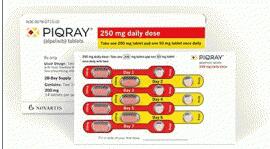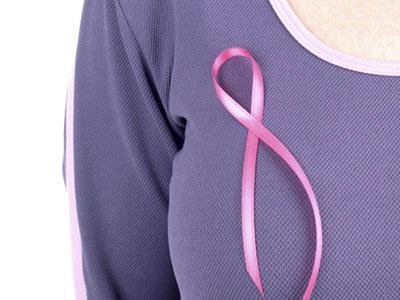阿培利司Piqray Tablets 50mg(alpelisib)
 产地国家:美国
处方药:是
所属类别: 50毫克/片 28片/盒
包装规格: 50毫克/片 28片/盒
计价单位:盒
生产厂家英文名:Novartis Pharmaceuticals
原产地英文商品名:Piqray 50mg/tablets 28tablets/box
原产地英文药品名:alpelisib
中文参考商品译名:Piqray 50毫克/片 28片/盒
中文参考药品译名:alpelisib
产地国家:美国
处方药:是
所属类别: 50毫克/片 28片/盒
包装规格: 50毫克/片 28片/盒
计价单位:盒
生产厂家英文名:Novartis Pharmaceuticals
原产地英文商品名:Piqray 50mg/tablets 28tablets/box
原产地英文药品名:alpelisib
中文参考商品译名:Piqray 50毫克/片 28片/盒
中文参考药品译名:alpelisib
简介
新型抗癌药Piqray(alpelisib)获FDA批准上市,为第一个也是唯一一个专门针对HR+/HER2-晚期乳腺癌PIK3CA突变患者的治疗药物近日,美国食品和药物管理局(FDA)批准Piqray(alpelisib,以前称为BYL719)与氟维司群联合用于治疗绝经后妇女和激素受体阳性的男性,人类表皮生长因子受体-2阴性(HR+/HER2-),PIK3CA-突变,晚期或转移性乳腺癌,在基于内分泌的方案之后或之后通过FDA批准的测试检测。 Piqray是一种激活抑制剂,与氟维司群联合用于治疗绝经后妇女和男性患有HR+/HER2,PIK3CA-突变,晚期或转移性乳腺癌,在内分泌或内分泌后进行的FDA批准的检测中检测到基于治疗方案大约40%的HR +晚期乳腺癌患者具有可能激活PI3K-α同种型的突变,称为PIK3CA突变。这些突变与内分泌治疗,疾病进展和预后不良有关。Piqray通过抑制PI3K途径(主要是PI3K-α同种型)起作用,以解决PIK3CA突变的影响。批准日期:2019年5月24日 公司:诺华公司PIQRAY(alpelisib)片剂,用于口服美国最初批准:2019年 作用机制: Alpelisib是磷脂酰肌醇-3-激酶(PI3K)的抑制剂,其抑制活性主要针对PI3Kα。编码PI3K的催化α-亚基(PIK3CA)的基因中的功能获得性突变导致PI3Kα和Akt信号传导的活化,细胞转化和体外和体内模型中肿瘤的产生。在乳腺癌细胞系中,alpelisib抑制PI3K下游靶标的磷酸化,包括Aktand在携带PIK3CA突变的细胞系中显示出活性。在体内,alpelisib抑制PI3K/Aktsignaling途径并减少异种移植模型中的肿瘤生长,包括乳腺癌模型。已显示通过alpelisib治疗的PI3K抑制诱导乳腺癌细胞中雌激素受体(ER)转录的增加。 与来自ER阳性,PIK3CA突变的乳腺癌细胞系的异种移植模型中的单独治疗相比,alpelisib和氟维司群的组合显示出增加的抗肿瘤活性。 适应症和用法 PIQRAY是一种激酶抑制剂,与氟维司群联合用于治疗绝经后妇女和男性,激素受体(HR)阳性,人表皮生长因子受体2(HER2)阴性,PIK3CA突变,晚期或转移性乳腺癌在基于内分泌的方案之后或之后通过FDA批准的测试检测。 剂量和给药推荐剂量: 每日一次口服300毫克(两片150毫克片剂)食物。对于不良反应,请考虑剂量中断,剂量减少或停药。 剂量形式和强度片剂:50mg,150mg,200mg 禁忌症:对PIQRAY或其任何成分严重超敏反应。 警告和注意事项:严重超敏反应:永久停止PIQRAY。及时开始适当的治疗。严重皮肤反应:报告了严重皮肤反应的病例,包括Stevens-Johnson综合征(SJS)和红斑多形性(EM)。不要对有史密斯,EM或毒性表皮坏死松解症(TEN)病史的患者进行治疗。如果存在严重皮肤反应的症状症状,则中断PIQRAY,直至确定反应的病因。考虑咨询皮肤科医生。如果确认SJS,EM或TEN,则永久停止PIQRAY。高血糖:报告了严重的高血糖,包括酮症酸中毒。 PIQRAY在1型或非控制性2型糖尿病患者中的安全性尚未确定。在开始用PIQRAY治疗之前,测试空腹血糖(FPG),HbA1c和优化血糖。在开始治疗后,监测期间。如临床指示,启动或优化抗高血糖药物。如果发生严重的高血糖,中断,减少剂量或停止PIQRAY。肺炎:已报道严重的肺炎和间质性肺病。监测临床症状或放射学变化。如果发生严重肺炎,则中断或停止PIQRAY。腹泻:据报道,有严重的腹泻病例,包括脱水和急性肾损伤。大多数患者在使用PIQRAY治疗期间出现腹泻(≤2级)。建议患者开始抗腹泻治疗,增加口服液,并在发生腹泻时通知医务人员。如果发生切断性腹泻,则中断,减少剂量或停止PIQRAY。胚胎 - 胎儿毒性:PIQRAY会导致胎儿伤害。告知患有胎儿潜在风险的患者并使用有效的避孕措施。另外,请参阅氟维司群有关怀孕和避孕信息的完整处方信息。不良反应最常见的 不良反应:包括实验室异常(全部,发病率≥20%),葡萄糖增加,肌酐增加,腹泻,皮疹,淋巴细胞计数减少,GGT增加,恶心,ALT增加,疲劳,血红蛋白减少,脂肪酶增加,食欲减退,口腔炎,呕吐,体重下降,钙减少,血糖下降,aPTT延长,脱发。 药物相互作用:CYP3A4诱导剂:避免PIQRAY与强效CYP3A4诱导剂共同给药。BCRP抑制剂:避免在接受PIQRAY治疗的患者中使用BCRP抑制剂。如果无法使用替代药物,请密切监测增加的不良反应。CYP2C9底物:当PIQRAY与CYP2C9底物共同施用时密切监测,其中这些药物的血浆浓度降低可能降低活性。 用于特定人群哺乳期:建议不要母乳喂养。 包装提供/存储和处理:PIQRAY(alpelisib)50mg,150mg和200 mg薄膜包衣片[见剂型和强度]。每日300毫克剂量:每个纸箱包含2个泡罩包装。 每个泡罩包装的14天供应量为28片剂(28片,每片150mg alpelisib)。 NDC 0078-0708-02250毫克每日剂量:每个纸箱包含2个泡罩包装。 每个泡罩包装的14天供应量为28片剂(14片,每片200mg alpelisib和14片,每片50mg alpelisib)。NDC 0078-0715-02每日200毫克剂量:每个纸箱包含1个泡罩包装。 每个泡罩包装包含28天的28片药片(每片28片,200mg alpelisib)。NDC 0078-0701-84储存温度为20°C至25°C(68°F至77°F),允许偏差在15°C至30°C(59°F至86°F)之间[见USP受控室温]。英文版说明书
PIQRAY(alpelisib) tablets, for oral useInitial U.S. Approval: 2019IndicationPIQRAY® (alpelisib) tablets is indicated in combination with fulvestrant for the treatment of postmenopausal women, and men, with hormone receptor (HR)-positive, human epidermal growth factor receptor 2 (HER2)-negative, PIK3CA-mutated, advanced or metastatic breast cancer as detected by an FDA-approved test following progression on or after an endocrine-based regimen.Important Safety InformationPIQRAY is contraindicated in patients with severe hypersensitivity to it or any of its components.Severe Hypersensitivity: Severe hypersensitivity reactions, including anaphylaxis and anaphylactic shock, were reported in patients treated with PIQRAY. Severe hypersensitivity reactions were manifested by symptoms including, but not limited to, dyspnea, flushing, rash, fever, or tachycardia. The incidence of grade 3 and 4 hypersensitivity reactions was 0.7%. Advise patients of the signs and symptoms of severe hypersensitivity reactions. Permanently discontinue PIQRAY in the event of severe hypersensitivity.Severe Cutaneous Reactions: Severe cutaneous reactions, including Stevens-Johnson syndrome (SJS) and erythema multiforme (EM) were reported in patients treated with PIQRAY. SJS and EM were reported in 0.4% and 1.1% of patients, respectively. Do not initiate PIQRAY treatment in patients with a history of SJS, EM, or toxic epidermal necrolysis (TEN). If signs or symptoms of severe cutaneous reactions occur, interrupt PIQRAY until the etiology of the reaction has been determined. Consultation with a dermatologist is recommended.If SJS, TEN, or EM is confirmed, permanently discontinue PIQRAY. Do not reintroduce PIQRAY in patients who have experienced previous severe cutaneous reactions during PIQRAY treatment. If it is not confirmed, PIQRAY may require dose modifications, topical corticosteroids, or oral antihistamine treatment.Advise patients of the signs and symptoms of severe cutaneous reactions (eg, a prodrome of fever, flu-like symptoms, mucosal lesions, or progressive skin rash).Hyperglycemia: Severe hyperglycemia, including ketoacidosis, has been reported in patients treated with PIQRAY. Hyperglycemia was reported in 65% of patients treated with PIQRAY. Grade 3 (FPG >250-500 mg/dL) and Grade 4 (FPG >500 mg/dL) hyperglycemia was reported in 33% and 3.9% of patients, respectively. Ketoacidosis was reported in 0.7% of patients (n=2) treated with PIQRAY.Before initiating treatment with PIQRAY, test FPG, HbA1c, and optimize blood glucose. After initiating treatment with PIQRAY, monitor blood glucose and/or FPG at least once every week for the first 2 weeks, then at least once every 4 weeks, and as clinically indicated. Monitor HbA1c every 3 months and as clinically indicated. If a patient experiences hyperglycemia after initiating treatment with PIQRAY, monitor blood glucose and/or FPG as clinically indicated, and at least twice weekly until blood glucose or FPG decreases to normal levels. During treatment with antidiabetic medication, continue monitoring blood glucose or FPG at least once a week for 8 weeks, followed by once every 2 weeks and as clinically indicated. Consider consultation with a health care practitioner with expertise in the treatment of hyperglycemia and counsel patients on lifestyle changes.The safety of PIQRAY in patients with type 1 and uncontrolled type 2 diabetes has not been established as these patients were excluded from the SOLAR-1 trial. Patients with a medical history of type 2 diabetes were included. Patients with a history of diabetes mellitus may require intensified diabetic treatment. Closely monitor patients with diabetes.Based on the severity of the hyperglycemia, PIQRAY may require dose interruption, reduction, or discontinuation. Advise patients of the signs and symptoms of hyperglycemia (eg, excessive thirst, urinating more often than usual or higher amount of urine than usual, or increased appetite with weight loss).Pneumonitis: Severe pneumonitis, including acute interstitial pneumonitis and interstitial lung disease, has been reported in patients treated with PIQRAY. Pneumonitis was reported in 1.8% of patients treated with PIQRAY.In patients who have new or worsening respiratory symptoms or are suspected to have developed pneumonitis, interrupt PIQRAY immediately and eva luate the patient for pneumonitis. Consider a diagnosis of non-infectious pneumonitis in patients presenting with non-specific respiratory signs and symptoms such as hypoxia, cough, dyspnea, or interstitial infiltrates on radiologic exams and in whom infectious, neoplastic, and other causes have been excluded by means of appropriate investigations.Permanently discontinue PIQRAY in all patients with confirmed pneumonitis. Advise patients to immediately report new or worsening respiratory symptoms.Diarrhea: Severe diarrhea, including dehydration and acute kidney injury, occurred in patients treated with PIQRAY. Most patients (58%) experienced diarrhea during treatment with PIQRAY. Grade 3 diarrhea occurred in 7% (n=19) of patients. Based on the severity of the diarrhea, PIQRAY may require dose interruption, reduction, or discontinuation. Advise patients to start antidiarrheal treatment, increase oral fluids, and notify their health care provider if diarrhea occurs while taking PIQRAY.Embryo-Fetal Toxicity: Based on findings in animals and its mechanism of action, PIQRAY can cause fetal harm when administered to a pregnant woman. Advise pregnant women and females of reproductive potential of the potential risk to a fetus. Advise females of reproductive potential to use effective contraception during treatment with PIQRAY and for 1 week after the last dose. Advise male patients with female partners of reproductive potential to use condoms and effective contraception during treatment with PIQRAY and for 1 week after the last dose. Refer to the Full Prescribing Information of fulvestrant for pregnancy and contraception information.The most common adverse reactions (all grades, incidence ≥20%) were diarrhea (58%), rash (52%), nausea (45%), fatigue (42%), decreased appetite (36%), stomatitis (30%), vomiting (27%), weight decreased (27%), and alopecia (20%). The most common grade 3/4 adverse reactions (incidence ≥2%) were rash (20%), diarrhea (7%), fatigue (5%), weight decreased (3.9%), nausea (2.5%), stomatitis (2.5%), and mucosal inflammation (2.1%).The most common laboratory abnormalities (all grades, incidence ≥20%) were glucose increased (79%), creatinine increased (67%), lymphocyte count decreased (52%), gamma glutamyl transferase (GGT) increased (52%), alanine aminotransferase (ALT) increased (44%), hemoglobin decreased (42%), lipase increased (42%), calcium decreased (27%), glucose decreased (26%), and activated partial thromboplastin time (aPTT) prolonged (21%).The most common grade 3/4 laboratory abnormalities (incidence ≥5%) were glucose increased (39%), GGT increased (11%), lymphocyte count decreased (8%), and lipase increased (7%), and potassium decreased (6%).用药温馨提示:当您服用此药物时,需定期接受医疗专业人士的检查,以便随时针对其药效、副作用等情况进行监测。本网站所包含的信息旨在为患者提供帮助,不能代替医学建议和治疗。
药品价格查询,专业药品查询网站,药品说明书查询,药品比价 » 阿培利司Piqray Tablets 50mg(alpelisib)
药品价格查询,专业药品查询网站,药品说明书查询,药品比价 » 阿培利司Piqray Tablets 50mg(alpelisib)




